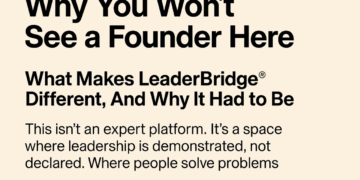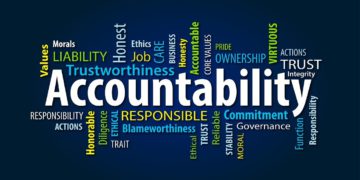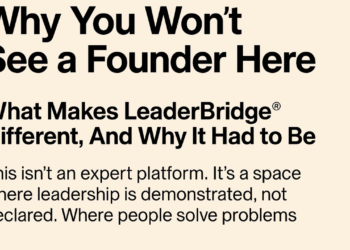A Thought Experiment

Imagine this: You’re scrolling through LinkedIn, and someone leaves a thoughtful comment on a post. If you know them, you’ll consider the source. If you don’t, before even reading their comment thoroughly, you pause. You check their profile.
Who is this person? What’s their title? Where are they located? How many connections do they have?
Only after scanning their background do you return to their comment. And now, everything they’ve said is filtered through what you’ve learned about them.
This is natural, we don’t just respond to words; we respond to people. And in many settings, that’s functional. But what happens when we strip all of that away?
What happens when leadership is tested without status, reputation, or any external validation to lean on?
That’s what we’re exploring here.
Stripping Away the Shortcuts to Focus on the Challenge
In this thought experiment every leadership challenge begins the same way: an anonymous, text-based challenge.
At any point, participants can choose to move to audio or video, but the experience always starts with a unique kind of focus, one where leadership is demonstrated first, without the usual social shortcuse:
• No LinkedIn profile to check.
• No voice tone to gauge confidence.
• No facial expressions to read for approval or hesitation.
• No status indicators to signal credibility.
Some may wonder, if leadership development depends on trust, doesn’t anonymity get in the way?
Actually, it’s the opposite. This model doesn’t eliminate relationship-building; it simply reverses the usual process. Instead of forming impressions based on who someone is first, participants get to know each other through how they lead and problem-solve. Over time, they have the option to engage in deeper ways, on their own terms.
Trust still develops, but it’s built through demonstrated capability, rather than through assumptions based on status, background, or first impressions.
This kind of openness is rare in leadership. Almost without exception we rely on available social context. But in this thought experiment, none of that exists. Which means that a different level of presence, adaptability, and problem-solving is required.
A “challenge” model for leadership development
Unlike typical leadership programs where relationships build over time, in this approach each challenge stands alone.
Participants do not control whether they can return to a previous challenge partner. Instead, every new challenge is initiated through a structured, self-directed matching process.
• No friend lists.
• No saved contacts.
• No direct “reaching back out.”
While participants can continue conversations outside the challenge, the program itself does not facilitate ongoing connections. The reason?
In this hypothetical experience leadership is judged only by the quality of thought and action within each challenge.
The only exception is after the experience, where participants reflect and share how it helped them in the real world.
So in this experience each challenge is a focused practice opportunity designed to refine leadership skills in ways that directly transfer to work.
From Social Perception to Leadership Performance
Instead of assessing who someone is, this type of challenge forces a focus on how they lead:
• Can they clearly articulate a problem?
• Can they move the conversation forward?
• Can they adapt, listen, and refine their thinking?
When we “practice” leading this way, patterns emerge, not about someone’s background, but about their actual behaviors.
How This Strengthens Leadership in the Real World
When we practice leadership by engaging purely through action and problem-solving, several things start to shift:
• Sharper Decision-Making – More focus on how challenges are navigated leads to faster, more effective problem-solving.
• Objective Assessment of Others – Leaders learn to evaluate input based on insight and execution, rather than professional hierarchy.
• Ability to Work Across Styles – Some leaders are more direct, others more process-oriented. This practice builds adaptability in working across different styles.
• Increased Self-Awareness – Without external validation or bias-driven feedback, leaders get a clearer sense of their true strengths and blind spots.
The result? Not just better leadership in the moment, but a sharper ability to lead anywhere, with anyone.
Refining Leadership, Not Replacing It
This approach to practicing leadership can sharpen the essential elements that matter most, especially for new and emerging leaders:
• Leading effectively in unfamiliar or high-pressure situations.
• Communicating clearly and guiding productive discussions.
• Adapting to feedback and refining leadership in real time.
• Strengthening confidence in leading without formal authority.
It’s not about changing how leadership works, it’s about fine-tuning it for sharper performance.
The Discomfort Is the Point
If the first few challenges feel strange or even unsettling, that’s normal.
It means you’re engaging with leadership in its purest form, without distractions, shortcuts, or external influence.
Over time, the process becomes clearer. The lessons sharpen. The impact builds.
And that discomfort?
That’s the signal that real learning is happening.
Final Thoughts
This approach to leadership development removes bias, distraction, and external influence, focusing entirely on thought, action, and problem-solving.
Would love to hear your thoughts, how do you think leadership would change if we stripped away all the usual social shortcuts?
Explore More from This Series
This article is part of an ongoing exploration of leadership development, dating back to our 2019 pieces in Harvard Business Review and Forbes. Below, you’ll find links to our other articles that further develop these ideas:
Foundational Articles (2019)
• Getting the Most Out of 360-Degree Reviews (Harvard Business Review)
• How to Find Safe Sounding Boards Outside Your Company
Exploring Leadership Practice & Development
• How Emerging Leaders Can Accelerate Development (Forbes)
• From Theory to Practice: How the DOER-R Framework Builds Daily Leadership
• The Leadership Tool You’ll Actually Use: A Practical Guide
• Leadership Practice: AI Can’t Replace What Matters Most
• Accelerating Leadership Growth Through Structured Practice
• The Leadership Skill Most People Never Practice (But Should)
• Could Anonymity Be an Accelerator for Leadership Growth?
Social Discussion & Engagement

































